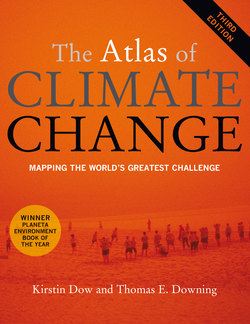Читать книгу The Atlas of Climate Change - Professor Kirstin Dow - Страница 18
На сайте Литреса книга снята с продажи.
Оглавление5% below 1990 levels in the commitment period 2008 to 2012. The Kyoto Protocol entered into force in 2005 after Annex I countries representing at least 55 percent of emissions by industrialized countries ratified it. Long-wave radiation Radiation emitted by the Earth’s surface, the atmosphere, and clouds, also known as terrestrial or infrared radiation. Mitigation Anthropogenic intervention to reduce the sources or enhance the sinks of greenhouse gases. MOP Meeting of Parties to the Kyoto Protocol. Multidecadal variability Climate variations occurring over timescales of one to three decades. Paleoclimate Climate for periods prior to the development of measuring instruments, including historic and geologic time, for which only proxy climate records are available. Photovoltaics Panels used to convert the sun’s radiation into electricity, also called solar cells. Precipitation Water in solid or liquid form that falls to Earth’s surface from clouds. Proxy climate indicator A preserved record of climate conditions before the instrumental record, derived using physical or biophysical principles. Radiative forcing Change in the net vertical radiation at the boundary between the lower and upper atmosphere (the tropopause) due to an internal change or a change in the external forcing of the climate system, such as a change in the concentration of carbon dioxide or the output of the sun. Terrestrial Relating to the land. Thermohaline circulation Large-scale density-driven circulation in the ocean, caused by differences in temperature (thermo) and salinity (haline). UNFCCC United Nations Framework Convention on Climate Change, adopted on 9 May 1992 in New York and signed at the 1992 Earth Summit in Rio de Janeiro by more than 150 countries and the European Community. Its ultimate objective is the “stabilization of greenhouse gas concentrations in the atmosphere at a level that would prevent dangerous anthropogenic interference with the climate system.” It contains commitments for all Parties and entered into force in March 1994. Weather The state of the atmosphere at some place and time described in terms of such variables as temperature, cloudiness, precipitation and wind. Regions Annex B countries are listed in Annex B in the Kyoto Protocol and have agreed to a target for their greenhouse gas emissions. They include the Annex I countries except Turkey and Belarus. Annex I countries Group of countries included in Annex I (as amended in 1998) to the UNFCCC, including all the developed countries in the OECD, and economies in transition. By default, the other countries are referred to as non-Annex I countries. Under Articles 4.2(a) and 4.2(b) of the Convention, Annex I countries commit themselves to the aim of returning to their 1990 levels of greenhouse gas emissions by the year 2000. EIT Economies in transition, countries with national economies in the process of changing from a planned economic system to a market economy. Refers to the former communist countries of Europe. EU European Union. Data for 2000 to 2004 refer to 15 members: Austria, Belgium, Denmark, Finland, France, Germany, Greece, Ireland, Italy, Luxembourg, Netherlands Portugal, Spain, Sweden and United Kingdom. Data for 2004 onwards refer to 25 member countries, which includes Cyprus, the Czech Republic, Estonia, Hungary, Latvia, Lithuania, Malta, Poland, Slovakia and Slovenia. G8 Group of Eight countries: Canada, France, Germany, Italy, Japan, the UK, USA, and Russia. The heads of government hold an annual economic and political summit meeting in the country currently holding the rotating presidency. LDCs The least developed countries, identified as such by the United Nations. OECD Organisation for Economic Co-operation and Development. 30 member countries sharing a commitment to democratic government and the market economy. OPEC Organization of the Petroleum Exporting Countries.
18
